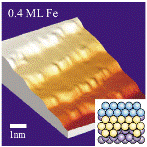Department of Physics and Astronomy: Publications and Other Research

Axel Enders Publications
Document Type
Article
Date of this Version
5-2010
Citation
physica status solidi (b) 247:5 (May 2010; Special Issue: Clusters at Surfaces), pp. 1063–1068; doi: 10.1002/pssb.200945510
Abstract
The role of the substrate on the morphology of nanometer size clusters fabricated by buffer layer assisted growth (BLAG) was studied using scanning tunneling microscopy. Clusters of Fe and Co were deposited on Ag(111), Cu(100), Rh(111), and Pt(111) surfaces using identical BLAG parameters, which are temperature, as well as metal and buffer layer coverage. Semi-hemispherical clusters are found on Ag(111) and Cu(100), while flat monolayer high islands are observed on Rh(111) and Pt(111) due to complete wetting. The results of this study are in agreement with the common notion that BLAG is useful to deposit clusters of virtually any material on any substrate, however, the shape, size, and lateral distribution of the resulting clusters depend strongly on the substrate surface free energy and diffusion processes.


Comments
Copyright © 2010 WILEY-VCH Verlag GmbH & Co. KGaA, Weinheim. Used by permission.